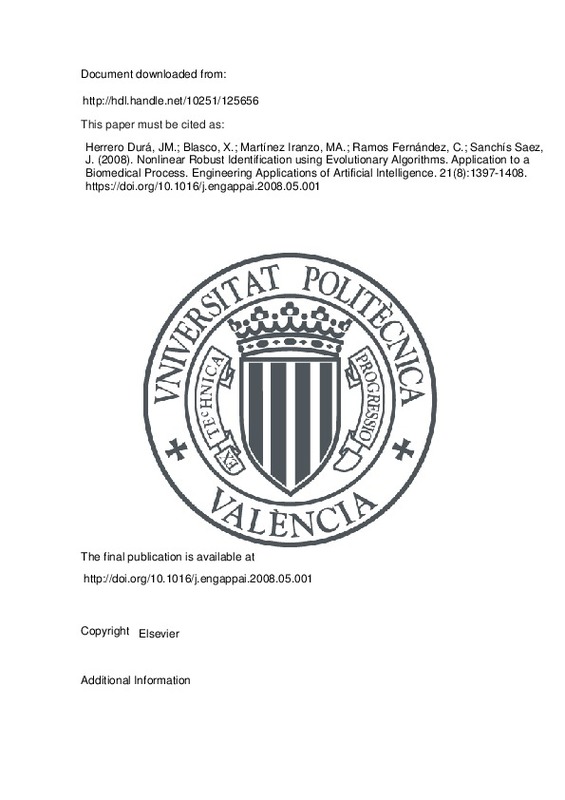JavaScript is disabled for your browser. Some features of this site may not work without it.
Buscar en RiuNet
Listar
Mi cuenta
Estadísticas
Ayuda RiuNet
Admin. UPV
Nonlinear Robust Identification using Evolutionary Algorithms. Application to a Biomedical Process
Mostrar el registro sencillo del ítem
Ficheros en el ítem
| dc.contributor.author | Herrero Durá, Juan Manuel
|
es_ES |
| dc.contributor.author | Blasco, Xavier
|
es_ES |
| dc.contributor.author | Martínez Iranzo, Miguel Andrés
|
es_ES |
| dc.contributor.author | Ramos Fernández, César
|
es_ES |
| dc.contributor.author | Sanchís Saez, Javier
|
es_ES |
| dc.date.accessioned | 2019-09-13T20:01:14Z | |
| dc.date.available | 2019-09-13T20:01:14Z | |
| dc.date.issued | 2008 | es_ES |
| dc.identifier.issn | 0952-1976 | es_ES |
| dc.identifier.uri | http://hdl.handle.net/10251/125656 | |
| dc.description.abstract | [EN] This work describes a new methodology for robust identification (RI), meaning the identification of the parameters of a model and the characterization of uncertainties. The alternative proposed handles non-linear models and can take into account the different properties demanded by the model. The indicator that leads the identification process is the identification error (IE), that is, the difference between experimental data and model response. In particular, the methodology obtains the feasible parameter set (FPS, set of parameter values which satisfy a bounded IE) and a nominal model in a non-linear identification problem. To impose different properties on the model, several norms of the IE are used and bounded simultaneously. This improves the model quality, but increases the problem complexity. The methodology proposes that the RI problem is transformed into a multimodal optimization problem with an infinite number of global minima which constitute the FPS. For the optimization task, a special genetic algorithm (epsilon-GA), inspired by Multiobjective Evolutionary Algorithms, is presented. This algorithm characterizes the FPS by means of a discrete set of models well distributed along the FPS. Finally, an application for a biomedical model which shows the blockage that a given drug produces on the ionic currents of a cardiac cell is presented to illustrate the methodology. (C) 2008 Elsevier Ltd. All rights reserved. | es_ES |
| dc.description.sponsorship | Partially supported by MEC (Spanish government) and FEDER funds: Projects DP12005-07835, DP12004-8383-CO3-02 and Generalitat Valenciana (Spain) Project GVA-026. | es_ES |
| dc.language | Inglés | es_ES |
| dc.publisher | Elsevier | es_ES |
| dc.relation.ispartof | Engineering Applications of Artificial Intelligence | es_ES |
| dc.rights | Reconocimiento - No comercial - Sin obra derivada (by-nc-nd) | es_ES |
| dc.subject | Robust identification | es_ES |
| dc.subject | Multimodal optimization | es_ES |
| dc.subject | Multiobjective optimization | es_ES |
| dc.subject | Evolutionary algorithms | es_ES |
| dc.subject | Biomedical processes | es_ES |
| dc.subject.classification | INGENIERIA DE SISTEMAS Y AUTOMATICA | es_ES |
| dc.title | Nonlinear Robust Identification using Evolutionary Algorithms. Application to a Biomedical Process | es_ES |
| dc.type | Artículo | es_ES |
| dc.identifier.doi | 10.1016/j.engappai.2008.05.001 | es_ES |
| dc.relation.projectID | info:eu-repo/grantAgreement/GVA//GV06%2F026/ES/Un nuevo sistema de producción inteligente: Optimización multiobjetivo con Physical Programming. Aplicación en control predictivo Multivariable/ | es_ES |
| dc.relation.projectID | info:eu-repo/grantAgreement/MEC//DPI2005-07835/ES/OPTIMIZACION MULTIOBJETIVO CON PHYSICAL PROGRAMMING. APLICACION A LA OPTIMIZACION DE CONSIGNAS EN CONTROL PREDICTIVO Y AL AJUSTE DE CONTROLADORES PREDICTIVOS MULTIVARIABLES/ | es_ES |
| dc.relation.projectID | info:eu-repo/grantAgreement/MEC//DPI2004-08383-C03-02/ES/GESTION DE LA RECIRCULACION DEL GAS DE ESCAPE EN MOTORES DIESEL TURBOALIMENTADOS. CONTROL PREDICTIVO MULTIVARIABLE./ | es_ES |
| dc.rights.accessRights | Abierto | es_ES |
| dc.contributor.affiliation | Universitat Politècnica de València. Departamento de Ingeniería de Sistemas y Automática - Departament d'Enginyeria de Sistemes i Automàtica | es_ES |
| dc.description.bibliographicCitation | Herrero Durá, JM.; Blasco, X.; Martínez Iranzo, MA.; Ramos Fernández, C.; Sanchís Saez, J. (2008). Nonlinear Robust Identification using Evolutionary Algorithms. Application to a Biomedical Process. Engineering Applications of Artificial Intelligence. 21(8):1397-1408. https://doi.org/10.1016/j.engappai.2008.05.001 | es_ES |
| dc.description.accrualMethod | S | es_ES |
| dc.relation.publisherversion | http://doi.org/10.1016/j.engappai.2008.05.001 | es_ES |
| dc.description.upvformatpinicio | 1397 | es_ES |
| dc.description.upvformatpfin | 1408 | es_ES |
| dc.type.version | info:eu-repo/semantics/publishedVersion | es_ES |
| dc.description.volume | 21 | es_ES |
| dc.description.issue | 8 | es_ES |
| dc.relation.pasarela | S\34046 | es_ES |
| dc.contributor.funder | Generalitat Valenciana | es_ES |
| dc.contributor.funder | Ministerio de Educación y Ciencia | es_ES |







![[Cerrado]](/themes/UPV/images/candado.png)

